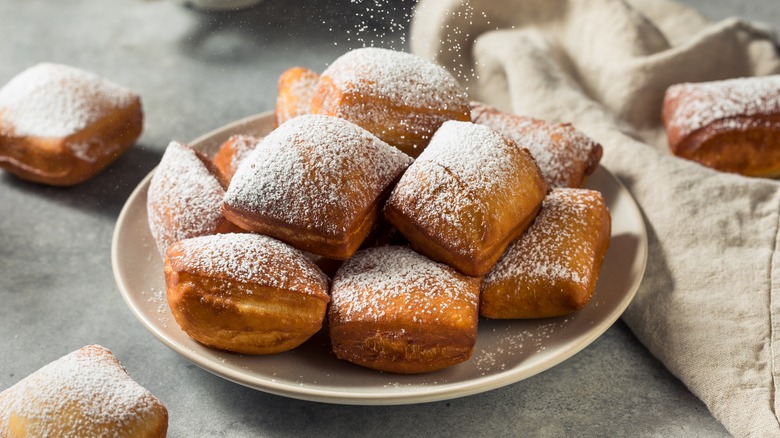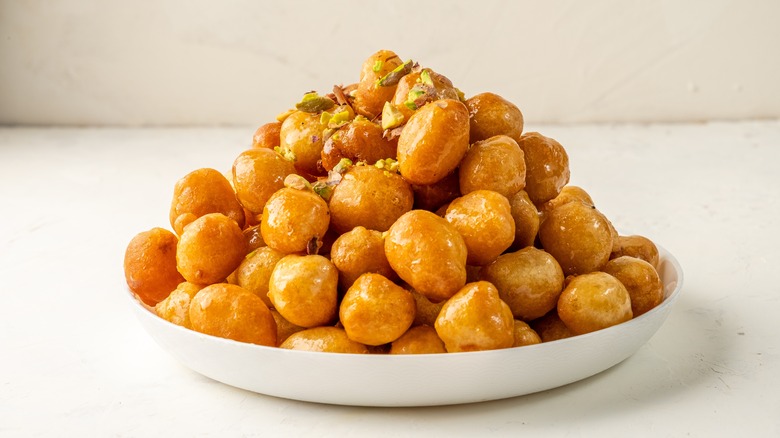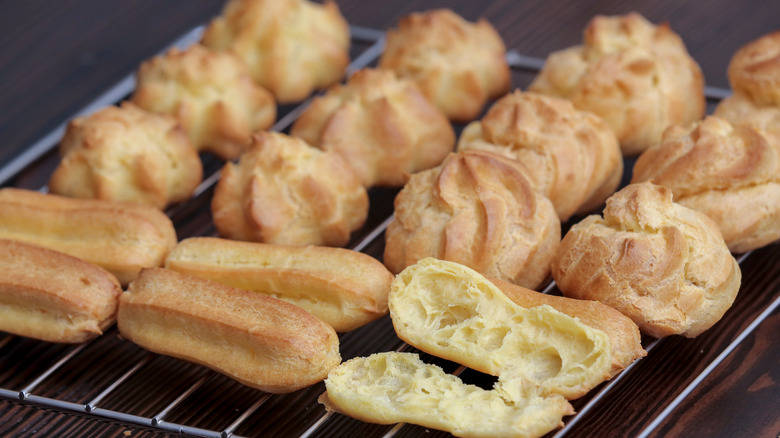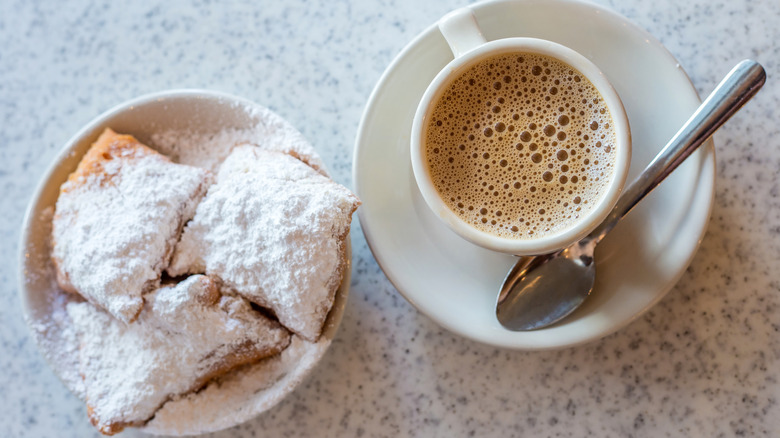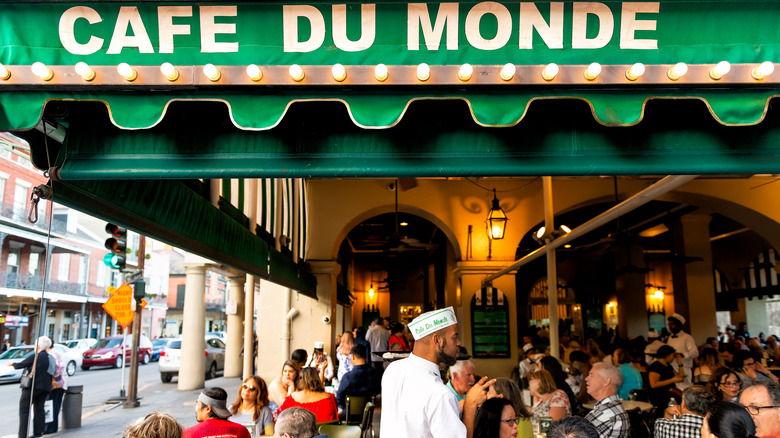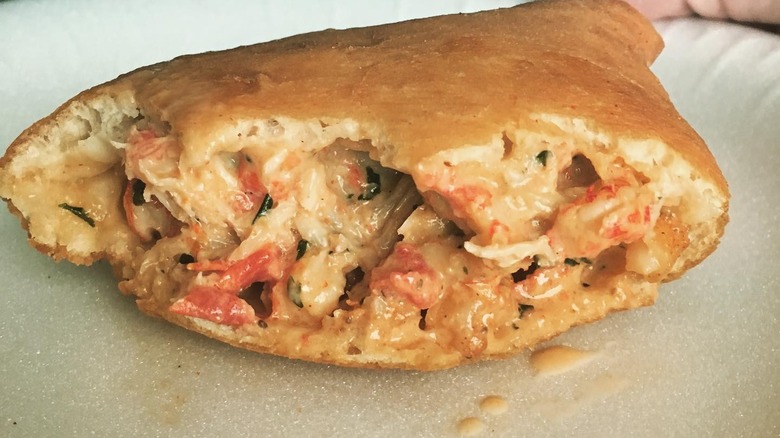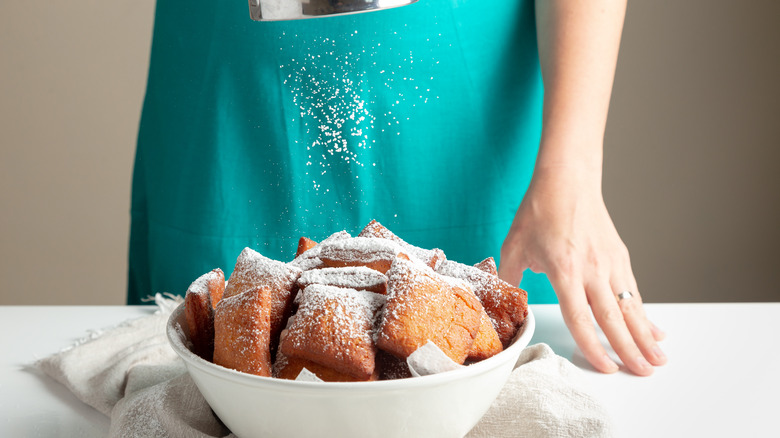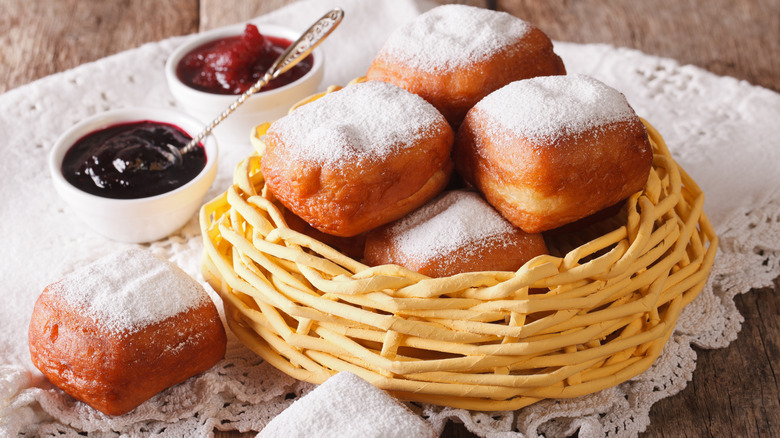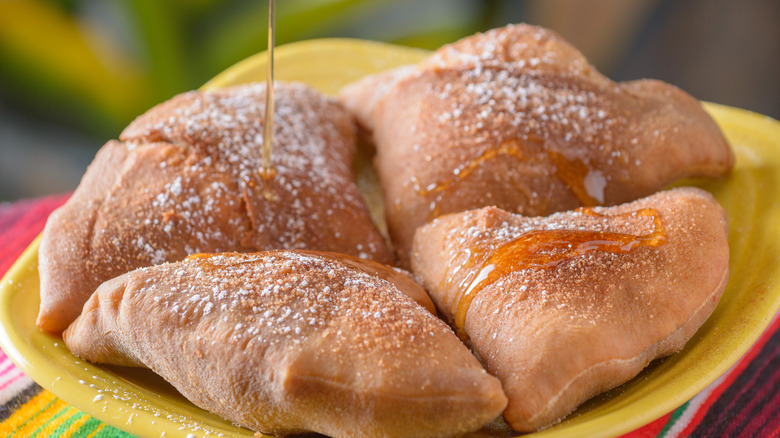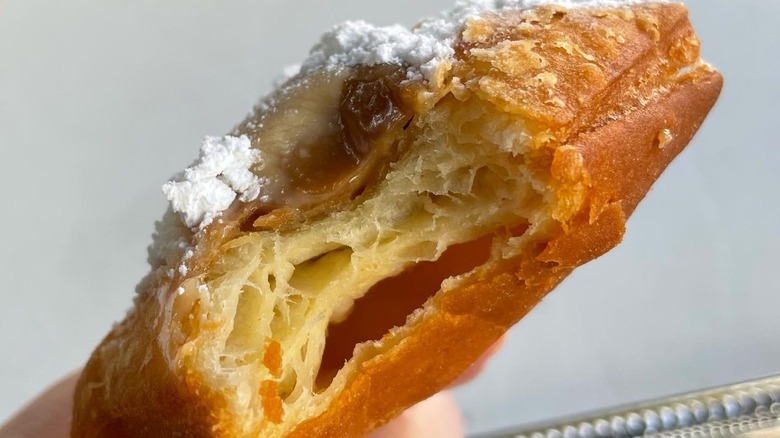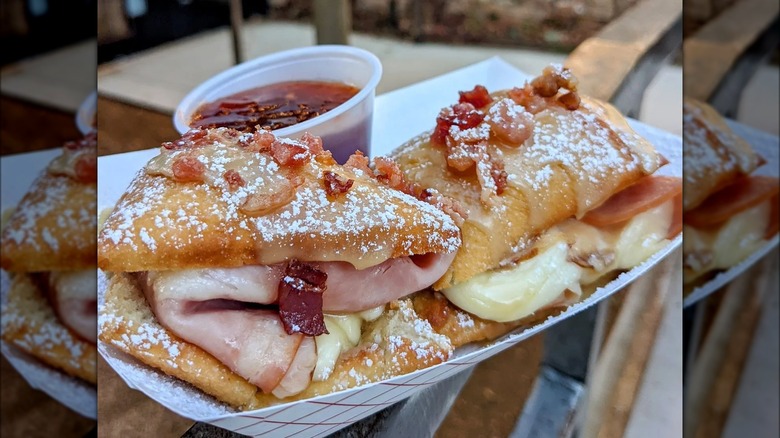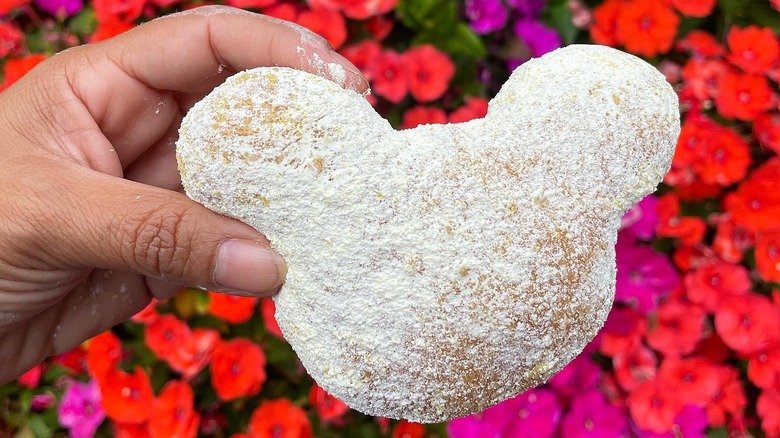The Truth About Beignets
We may receive a commission on purchases made from links.
If you have even a passing familiarity with New Orleans, then you probably know about beignets. If you don't, you're sure to want some the moment you make their acquaintance. A beignet is basically a type of doughnut without a hole. Usually, beignets are also free of fillings and are simply topped with extremely liberal amounts of powdered sugar. But there's a lot more to these puffy pillows of sweet fried dough than meets the eye.
Beignets have a long, well-traveled history and have been a fixture of New Orleans for centuries. In 1986, they even became the official state doughnut of Louisiana (via State Symbols USA). Thankfully, you can find beignets in lots of other places — and they're not that hard to make at home if you're so inclined.
When you behold a beignet, you might think you're looking at any number of other doughnuts, given that they bear striking similarities to sopapillas, among other fried dough favorites. Things can get even more confusing when you learn that there is more than one type of beignet, even within New Orleans, where the treat served at Cafe du Monde is the most iconic variety.
Below, you'll learn everything you need to know about beignets, including where to buy them, how to make them, and how to eat them — besides buried under a mountain of confectioner's sugar. Not that such a thing is ever a bad idea, so long as you don't wear black or inhale too close to your plate.
Beignets may have ancient Roman roots
According to "The Oxford Companion to Food," all doughnuts can probably be traced back to ancient Rome, where irregular pieces of sourdough-leavened batter were fried in oil. These snacks, called scriblita, bear an obvious resemblance to many kinds of doughnuts we eat today (Louisiana-style beignets are essentially just one type of yeast-raised doughnut).
Various forms of fried dough have existed throughout history and across multiple cultures, including in France, where the term "buigne" literally meant bump or lump. What's Cooking America traces it back to the ancient Celtic "bigne," which meant "to raise." In France, the derivative "beignet" came to mean "fritter" in general (per the Online Etymology Dictionary). It all makes sense when you think about how dough puffs up in hot oil.
Beignets were enjoyed in France as far back as the Middle Ages and may have been introduced there by Muslim travelers. Food historian Cathy Kaufman explored beignets' possible Islamic origins in a 2009 International Association of Culinary Professionals newsletter (via Rachel Laudan). Kaufman posits that luqam, similar fritters popular in Islamic-controlled Spain, traveled to Provence, spread throughout the rest of France, and acquired their new name.
French and Acadian settlers then brought beignets to New Orleans in the 18th century. An apocryphal story which credits Ursuline nuns for bringing the treat to the region could have arisen from the fact that another name for French beignets is the slightly vulgar "pets de nonne," as per Cook's Info.
Beignets are related to cream puffs, profiteroles, and churros
Traditionally, French beignets were made with pate a choux, a type of stiff, unleavened batter that is composed of flour, water (or milk), sugar, butter, and eggs. It's cooked twice; first on the stovetop to bring the ingredients together, then either baked or fried.
Rather than harnessing the power of leavening agents like baking powder or yeast, choux pastry depends on steam to make it puff up during the final baking or frying step, per Bakerpedia. Pate a choux is perhaps most famously formed into filled cream puffs, profiteroles, and eclairs, which are all baked and cooled before serving. It's also used to make Spanish churros, which of course are best eaten hot from the fryer.
Choux-based beignets are noticeably different from the square fritters you most often find in New Orleans. Because the thick and pasty choux dough is difficult to form into shapes unless you use a piping bag, fried choux beignets are usually spherical (it's no coincidence that "choux" means cabbage in French). Choux-based beignets have a lighter and airier texture as well. Properly made, the finished pastry will be hollow and ready for fillings like pastry cream or jam.
In a recipe for choux-based "bennets" from "The Book of Cookrye," a 16th-century English cookbook, the serving suggestion was simply to sprinkle sugar on top (via Ren Store).
There's more than one way to make beignets
New Orleans-style beignets are made from a yeasted dough that is rested, rolled out, and cut into squares before being fried (via Joe Gambino's Bakery). They're crisp outside yet light and fluffy within, though not hollow like choux beignets. For this reason, they're also not as good once they cool off, as they can become dense and gummy within a fairly short time period.
In their most well-known iteration, these yeast-risen, square or rectangular beignets come under a drift of snowy white powdered sugar that will send you into a coughing fit if you accidentally breathe it in. Meanwhile, the sugar will absolutely dust your clothes no matter how careful you are.
In France, yeasted beignets — round and without holes, though often filled with jelly — are called boules de Berlin. They're equivalent to Berliner doughnuts in the United States. While yeasted doughnuts and yeasted beignets are generally very similar, most beignets contain a different proportion of yeast and eggs (via MasterClass). Hence, they're puffier and slightly chewy while still being incredibly tender. Beignets can be made with all-purpose flour or higher-protein bread flour, but some recipes use low-protein cake flour for more delicate beignets.
Cafe du Monde put beignets on the map
There are plenty of places to find beignets in New Orleans but the most well-known is the legendary Cafe du Monde, which has been in business since 1862. Located in the French Market, Cafe du Monde is known for its square beignets served three to a plate, showered with powdered sugar, as well as its chicory coffee, which many enjoy as a cafe au lait on the side.
Originally, these airy, sugar-dusted squares were simply called French Market doughnuts. In 1958, then-owner of the Cafe du Monde, Hubert Fernandez, rebranded them with the fancier French name (via Biz New Orleans). A 1928 article about the cafe and the Morning Call coffee stand emphasized the egalitarian nature of these establishments and described the iconic holeless doughnuts both of them offered (via NOLA.com). Allegedly, a tourist tried to buy the Cafe du Monde beignet recipe for $250, equivalent to over $4,000 today. They were rebuffed.
While the specific recipe was never divulged, it's not hard to replicate, though the trick is all in the proper technique and having a vat of hot oil ready to fry it to perfect puffy crispness. However, the atmosphere of Cafe du Monde, with its green and white accents and twirling ceiling fans, adds a lot to the authentic New Orleans beignet experience.
Beignets can be sweet or savory
When it comes to New Orleans-style beignets, they're usually served under enough powdered sugar to choke a giraffe, but savory beignets are also a thing. Sometimes they're still square, as at The Vintage, which sometimes serves them sans sugar and occasionally topped with bacon gravy for breakfast. A poached egg is optional but highly encouraged. Stuph'd Beignets & Burgers likewise offers an array of savory beignets that are loaded with filling but still more or less square. These fritters come packed with seemingly everything, from a pepperoni pizza-inspired option to shrimp and crawfish fillings.
Other savory beignets bear far less resemblance to the iconic sugar-dusted squares, but they're still fritters, hence the name. Seafood beignets, including those made with crawfish, shrimp, and crab are popular in Louisiana and elsewhere in the south. They're generally small and spherical, made with an egg-based batter free of any leavening agents. Some places, like Katie's, add cheese, jalapenos, and caramelized onions to the mix. SoBou is known for its duck and sweet potato beignets.
Savory choux-based beignets also exist and often incorporate cheese, like gougeres. At home, you could also fry up a batch of New Orleans-style beignets and simply skip the sugar drift. Try grinding some black pepper over the top and showering them with a fluffy mound of shredded parmesan or asiago.
Beignets are easier to make than you might think
Even if you're miles away from New Orleans, it's not that hard to make beignets at home. That's good news, since they're best eaten as soon as possible. This beignet recipe relies on instant yeast as the leavening agent. Along with all-purpose flour, sugar, and eggs, it includes small amounts of shortening and evaporated milk. The shortening helps create beignets with fluffy, airy centers (plain butter can sometimes make them fall a little, although some people prefer the taste and texture). The evaporated milk adds richness to the dough, more so than if you used regular milk. If you don't do dairy, you can substitute full-fat coconut milk, although some people might detect a faintly tropical note.
While you're at work in the kitchen, be sure to avoid common beignet mistakes like overmixing your dough and not letting it rise long enough. Pay attention to the temperature of your water as well. Too hot and it could kill the yeast, resulting in flat, tough beignets. A deep fat frying or candy thermometer is handy for ensuring your oil is hot enough to make your beignets crisp and fluffy in just a couple of minutes. Break out your deepest Dutch oven or other heavy pot for frying too — but don't crowd it, because adding too many beignets at once will lower the temperature of the oil and lead to soggy sadness.
You can buy beignets outside of New Orleans
If there's no way you're making homemade beignets, you still have options that don't involve an expensive plane ticket (or waiting for Popeye's beignets to come back and potentially disappoint you anyway).
Owing to their best-fresh nature, it's actually not that easy to order beignets online. Goldbelly lists a couple of intriguing twists that may travel a bit better, including bagel beignets from Goldberg's Fine Foods in Atlanta and a stuffed beignet sampler kit from Brenda's French Soul Food in Louisiana. The latter comes with apple and chocolate fillings and arrives uncooked so you get to enjoy them straight from the fryer.
Your best bet, though, is to look for local bakeries and restaurants that make beignets in-house. You might be surprised at how many options abound throughout the United States and not just in major cities — though naturally, you're likely to get luckier there on a beignet hunt. Yelp lists several spots that specialize in beignets in Los Angeles, including Louisiana-bred Beignet Box, as well as several Cajun-style eateries that serve beignets alongside other classic New Orleans food.
There's a similarly broad spread of beignets in Chicago (via Yelp) and New York City (via Yelp), although, again, you may have to dig a little to find true New Orleans-style beignets. Reddit can be helpful here, too.
Beignets are almost the same as sopapillas
Mexican food fans may feel a flash of deja vu when beholding a plate of New Orleans-style beignets, which are a lot like sopapillas. Those puffy dough pillows are often triangular but are also relatively unadorned. Sopapillas usually get a generous drizzle of honey in addition to a shower of powdered sugar (when they're not rolled in a sandy cinnamon sugar coating, anyway). Toppings aside, they taste almost identical to beignets, although many sopapilla recipes are leavened with baking powder instead of yeast.
Yeasted beignets could also be doppelgangers for German fastnachts, square-shaped doughnuts that don't have holes and are usually served simply dusted with powdered sugar (via York Daily Record). However, fastnachts traditionally incorporate some form of potato in the dough, so they are noticeably softer and more dense than most varieties of beignets.
Portuguese malasadas, another yeasted doughnut, are much closer in taste and texture to beignets. Hugely popular in Hawaii, malasadas are generally rounder but also lack holes. They're often rolled in granulated sugar but sometimes come glazed or pumped up with fillings like haupia (coconut pudding).
Spanish-style buñuelos probably share a linguistic root with beignets and are more akin to the choux-based version. However, you can find buñuelos leavened with baking powder or yeast. Still others resemble super-crispy fried tortillas rather than doughy pillows or spherical puffs. Italian zeppoles are like choux-based beignets too, and are often served with nothing but a dusting of confectioner's sugar.
Beignets don't have to stop at powdered sugar
Before they get smothered under snowy sugar, New Orleans-style beignets taste like plain doughnuts that aren't too sweet. We're talking the fluffier yeasted kind, of course. Denser cake doughnuts tend to be a little less complex, sweeter, and more buttery. They also often contain vanilla, cinnamon, and other ingredients. There's a very faint tang to yeasted dough, and frying it provides not only a fantastic texture but an extra layer of richness after the golden-brown shell caramelizes in the hot fat. Yeasted beignets aren't as eggy as choux-based beignets, either.
While a drift of powdered sugar is all you need to complement the dough itself, you can find sweet beignets with tons of other toppings and sauces, either in addition to or instead of confectioner's sugar. You'll find cinnamon syrup and buttercream syrup at Mo'Bay Beignet Company, for instance. Plenty of places offer caramel sauce or chocolate ganache for dipping. Your favorite fruity jam would be a perfect partner, too. Something slightly sharp, like raspberry preserves, cuts through the sweetness nicely.
Just as there are stuffed savory beignets, there are stuffed sweet beignets as well, like those at Loretta's Authentic Pralines, which ooze caramel and pecans. Meanwhile, the Oreo beignet at New Orleans' Luca Eats may look more like a state fair snack than a French Quarter beignet, but it's undeniably delicious. The Vintage's chocolate-glazed s'mores beignet is filled with melted marshmallow and scattered with graham cracker crumbs (via Facebook).
There's a beignet festival for true fans
You probably won't be surprised to learn that Beignet Fest happens in New Orleans. The celebration of the city's favorite fritter kicked off in 2016 (via My New Orleans) and features numerous vendors serving beignets in every iteration, from the classic sugar-dusted squares to inventive sweet and savory spins. There's also live music, local art, and an anthropomorphized beignet mascot named Benny (via Instagram). Anyone who feels like they need a good excuse to eat a bunch of beignets can find it in the fact that Beignet Fest proceeds go toward organizations that support children with autism and developmental delays.
Beignets have been considered festival food long before they had their own dedicated day. While many people associate Mardi Gras more with beads and booze, "Fat Tuesday" has been closely linked to delicious fried foods of all kinds as well.
Marci Gras isn't just a celebration of all things indulgent before the lean period of Lent. Practically speaking, Shrove Tuesday was also the last day observant households could make use of oil, lard, butter, and sugar before abstaining from such rich substances (via NPR). Therefore, doughnuts and fritters were popular treats to enjoy just before Ash Wednesday, including Polish paczki and German fastnachts (fastnacht literally translates to "fast night"). In predominantly French New Orleans, beignets were always big. But they also became an everyday option, unlike more labor-intensive king cake, which is still usually a once-a-year treat.
Beignets are big at Disney too
Among fan-favorite Disney foods, churros and Dole Whip might be better known sweet treats, but beignets are a hot item at the parks as well. At Disneyland in California, beignets are available in the standard square variety and a Mickey-shaped version at the Mint Julep Bar in New Orleans Square within the park (via Tips from the Disney Diva). In addition to the plain powdered sugar variety, they offer seasonal beignet flavors like pumpkin spice and peppermint. A couple other locations in the Downtown Disney District also offer beignets, but only in the standard flavor and not in the popular mouse ear shape.
At Florida's Disney World, beignets are on the menu at Scat Cat's Club Cafe in the Port Orleans resort (via Disney Food Blog), where you can get strawberry sauce, salted caramel, or chicory-infused chocolate ganache with your Mickey-shaped beignets. Grown-ups can also go for boozy beignets filled with Bailey's Irish Cream, Kahlua, or RumChata liqueur. Meanwhile, anyone can opt for a beignet sundae — because what isn't made all the better with a scoop of ice cream on top?
The official Disney beignet recipe is made with the usual yeast-based dough, though it calls for heavy cream as the liquid dairy component (via Disney Parks). The only other thing you need to make Mickey beignets at home is the right cookie cutter to get the appropriate mouse ears shape.
